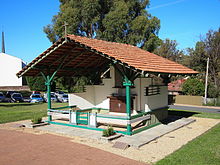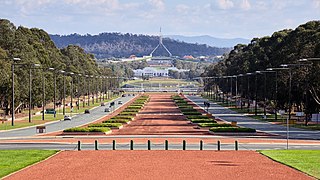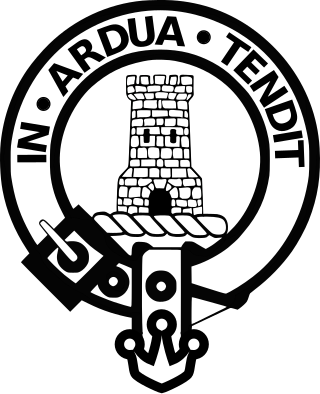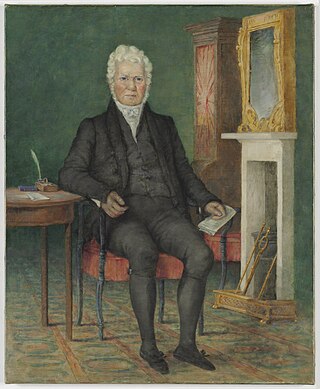This article needs additional citations for verification .(November 2016) |



Duntroon is a suburb of the city of Canberra in the Australian Capital Territory.
This article needs additional citations for verification .(November 2016) |



Duntroon is a suburb of the city of Canberra in the Australian Capital Territory.
Robert Campbell's property Duntroon was situated on the limestone plains of New South Wales in the area that is now covered by the ACT.
Given government compensation for the loss of his ship the Sydney while under government charter, Robert Campbell, sent James Ainslie to collect 700 sheep from the government flocks at Bathurst and to go southward looking for suitable pasture.
Ainslie reached the Limestone Plains and selected a site on the slopes above the Molonglo River where the Royal Military College now stands. In 1825 Campbell applied for and received his grant, naming it "Duntroon" after the family castle, Duntrune Castle on Loch Crinan in Argyll, Scotland. Duntrune Castle on Loch Crinan in Argyll, Scotland was sold to clan Malcolm in 1792, long before this.
In 1833, Campbell built "Duntroon House" out of stone with wide verandahs. In 1862 Robert's son George added a large two-storey extension. In its final form the house contained twenty rooms and is a great example of colonial architecture. It now serves as the officers' mess for the Royal Military College, Duntroon and is situated in the suburb of Duntroon, Canberra.
"Duntroon House" was the centre of activity for Campbell's station. Gardens were established around the house including many exotic trees and an intricate maze was grown also a conservatory, orchard, vineyard and dairy farm were built in the surrounding area.
Duntroon was recommended as the site for Australia's Military College by Lord Kitchener, who had been commissioned in 1910 to report on the country's defence needs. Initially the government rented Duntroon for two years before obtaining the title to Duntroon and its surrounding 360 acres (1.5 km2) through the creation of the Australian Capital Territory.
On 27 June 1911 the Royal Military College opened at Duntroon.
The Prisoner of War National Memorial is located at Duntroon. It consists of the Changi Chapel, which was originally constructed by Australian and British prisoners of war in Singapore in 1944. It was dismantled at the end of the war, packed away and taken to a military store in Australia. It was reconstructed using old diagrams and notes from the architect Hamish Cameron-Smith and unveiled in 1988 to commemorate the POWs.

In the east calcareous shales from the Canberra Formation is overlain by Quaternary alluvium. This rock is the limestone in the original name of Canberra "Limestone Plains". The Narrabundah Ashstone is part of this formation and can be seen in the easternmost corner. In the higher west including Mount Pleasant is grey quartz andesite from the Ainslie Volcanics. Around Australian Defence Force Academy is grey dacite from the Ainslie Volcanics. [1]
Geology of the Australian Capital Territory covers more of the geology of the ACT. [1]
Duntroon may refer to:

The Royal Military College, Duntroon, also known simply as Duntroon, is the Australian Army's officer training establishment. It was founded at Duntroon, in Canberra, Australian Capital Territory, in 1911 and is at the foot of Mount Pleasant near Lake Burley Griffin, close to the Department of Defence headquarters at Russell Hill. Duntroon is adjacent to the Australian Defence Force Academy (ADFA), which is Australian Defence Force's tri-service military academy that provides military and tertiary academic education for junior officers of the Australian Army, Royal Australian Air Force and the Royal Australian Navy.
The history of Canberra details the development of the city of Canberra from the time before European settlement to the city's planning by the Chicago architect Walter Burley Griffin in collaboration with Marion Mahony Griffin, and its subsequent development to the present day.

Mount Ainslie is a hill with an elevation of 843 metres (2,766 ft) AHD that is located in the northeastern suburbs of Canberra, in the Australian Capital Territory, Australia. Mount Ainslie lies within part of the Canberra Nature Park.

Campbell is a suburb of Canberra, Australian Capital Territory, Australia. Covering an area to the South East of the central business district, Campbell sits at the base of Mount Ainslie and is bounded to the south east by the Mount Pleasant Nature Reserve. At the 2021 census, Campbell had a population of 6,564 people.

Crinan is a small village located on the west coast of Scotland in the region known as Knapdale, which is part of Argyll and Bute. Before the Crinan Canal was built, Crinan was named Port Righ which meant the king's port. The canal was named from the small settlement of Crinan Ferry on the edge of Loch Crinan where a small ferry landed. The name Crinan probably derives from the Creones tribe who lived in the area in 140 AD. The canal starts at Ardrishaig sea loch on Loch Gilp, and ends nine miles away at Crinan sea loch on the Sound of Jura. The canal was designed to provide a short cut between the west coast and islands at one end and the Clyde estuary at the other, and so avoid the long voyage around the south end of the Kintyre Peninsula.
Symonston is a primarily industrial and agricultural suburb of Canberra, Australian Capital Territory, Australia. Symonston is named after Sir Josiah Symon a Legislator, Federalist and one of the Founders of the Constitution of Australia.

Anzac Parade is a significant road and thoroughfare in the Australian capital Canberra, used for ceremonial occasions and the site of many major military memorials.

Dickson is a suburb in the Inner North of Canberra, Australia. It is named after Sir James R. Dickson (1832–1901) who was a Queensland advocate of Australian Federation and one of the founders of the Australian Constitution. There is no specific theme for street names.

Ainslie is a suburb of Canberra, Australia in the North Canberra district.

Hackett is an inner north suburb of Canberra, the capital city of Australia. Located approximately 4.5 km north-east of the central business district, Hackett is adjacent to Watson, Dickson and Ainslie. It is bounded by Antill Street and Philip Avenue, and the Mount Majura Nature Reserve to the east. Hackett has a neighbourhood oval, and shopping centre.

Russell is a suburb of Canberra, Australia in the North Canberra district. Russell is one of the smallest suburbs in Canberra, comprising a number of government offices but no private residences. It is probably best known for the headquarters of the Australian Defence Force, which is housed in the Russell Offices complex.

Harrison is a suburb of the district of Gungahlin in Canberra, Australia. The suburb is named after the former city planner Peter Harrison, who was instrumental in reviving Walter Burley Griffin's plan for the National Capital. The suburb is adjacent to the suburbs of Franklin, Gungahlin, Throsby, Kenny and the industrial estate Mitchell. Harrison's place names reflects those of "natural features, waterfalls, plains, tablelands and plateaux". The suburb is located approximately 2 km east of the Gungahlin Town Centre and about 10 km from the centre of Canberra.

Education in the Australian Capital Territory covers early learning (pre-Kindergarten), primary (K–6), secondary (7–10), college or senior secondary (11–12), followed by studies as an adult at university or TAFE. Education includes those delivered by government agencies and those delivered under the Catholic systemic system and other non-government schools.
James Ainslie (1787–1844) was a Scottish soldier and shepherd, best known as the first overseer of the property known as Duntroon in the Australian Capital Territory. During his time on the Limestone Plains he is said to have had a relationship with an Aboriginal woman. After 10 years at Duntroon, Ainslie returned to Scotland and after numerous offences committed suicide in jail in 1844.

The geology of the Australian Capital Territory includes rocks dating from the Ordovician around 480 million years ago, whilst most rocks are from the Silurian. During the Ordovician period the region—along with most of eastern Australia—was part of the ocean floor. The area contains the Pittman Formation consisting largely of quartz-rich sandstone, siltstone and shale; the Adaminaby Beds and the Acton Shale.

Duntrune Castle is located on the north side of Loch Crinan and across from the village of Crinan in Argyll, Scotland. It is thought to be the oldest continuously occupied castle on mainland Scotland. It was the seat of the Campbells of Duntroon until 1792. The castle is a category B listed building.

The Clan Malcolm, also known as the Clan MacCallum, is a Highland Scottish clan. The Clan MacCallum may have originally been a separate clan until the 18th century, when the chief of the Clan MacCallum adopted the name Malcolm after inheriting the Malcolm estate, and the two clans were drawn together under the same chief.

Robert Campbell (1769–1846) was a merchant and politician in Sydney. He was a member of the first New South Wales Legislative Council. Campbell, a suburb of Canberra was named in his honour.
Majura is a district in the Australian Capital Territory in Australia. With a population of 161 at the 2021 census, excluding the suburb of Pialligo, which lies to the south of Canberra Airport. Apart from Pialligo, Majura District includes Canberra Airport, three business parks and some farming but little residential development. The main shopping centre is the Majura Park Shopping Centre.
![]() Media related to Duntroon, Australian Capital Territory at Wikimedia Commons
Media related to Duntroon, Australian Capital Territory at Wikimedia Commons